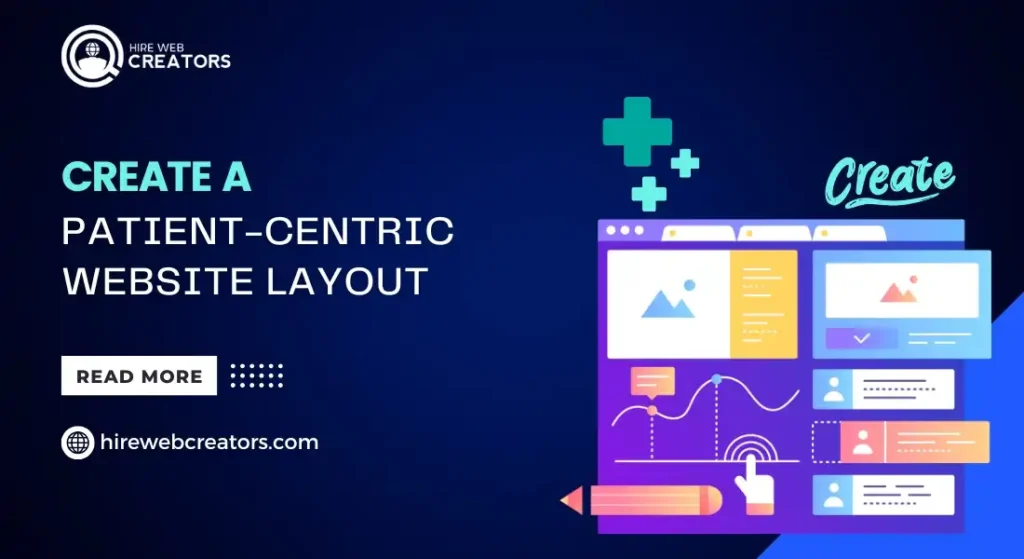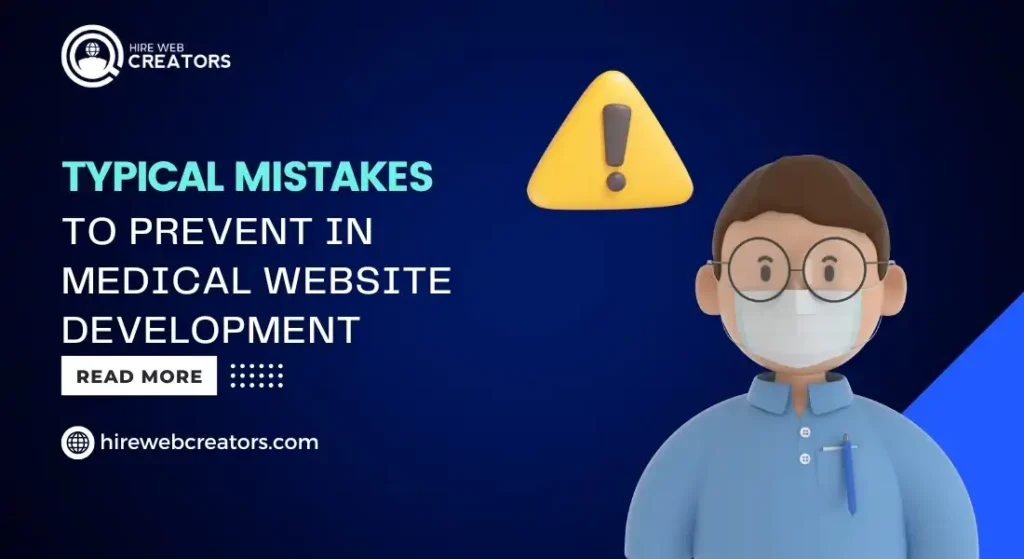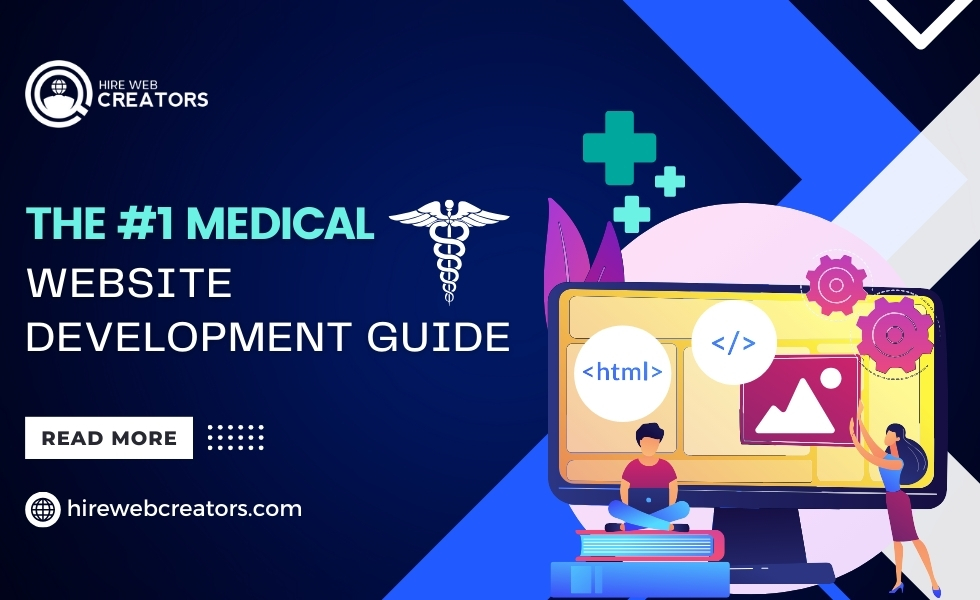Discover the #1 medical website development guide. Learn how to create a patient-friendly, professional, safe, and secure website that increases your web profile. A competent medical website is not optional in the digital era; it is rather necessary. Having a well-designed website can make all the difference between drawing in new business or losing it to rivals given that 80% of patients seek online before seeing a healthcare practitioner.
This book will instruct you:
- The main components of a successful medical website creation.
- Methodical approaches to produce an interesting, conforming, and user-friendly site.
- The best strategies to increase patient confidence, combine cutting-edge technologies, and improve SEO
Join along to discover how to create a medical website that satisfies industry criteria, increases patient involvement, and distinguishes itself.
Table of Contents
Advantages of Medical Website Development
For healthcare professionals, investing in medical website creation has several main benefits:

- Enhanced patient engagement results from a user-friendly website with capabilities like online booking, patient portals, and chat support keeping users connected and informed, thereby improving their whole experience.
- Digital tools including automated reminders, safe forms, and appointment scheduling help medical professionals to focus on patient care by helping to streamline administrative chores.
- Improved Credibility: A professional, well-optimized website shows your dependability and knowledge while helping possible patients locate and select your offerings.
First, Define Your Target Audience and goals for your website.
Clearly defined goals are absolutely important before starting to work on medical website development. Are your goals in teaching patients, providing simple appointment scheduling, or stressing particular services? Clearly defining your objectives helps you to make sure your website performs as intended.
Create thorough patient personas to learn the requirements and preferences of your target. Think about demography, health issues, and digital behavior. This will help you customize the user experience, increasing the relevance and appeal of your website for your target market.
Second Step: Decide on the Correct Platform for the Development of Medical Websites.
Medical website development depends critically on the platform chosen since it affects design freedom, user experience, and SEO performance. Popular choices can be quickly compared here:

- With so many medical-specific themes and plugins available, PHP provides great customization. It’s amazing for scalability and quite SEO-friendly.
- Wix: Perfect for smaller offices needing a quick setup, user-friendly with drag-and-drop tools. For sophisticated features, it provides little customizing though.
- Joomla is less beginner-friendly but flexible and safe; it may call for more technical knowledge.
Because of its adaptability and a large collection of plugins catered for medical websites, such as patient portals, appointment scheduling, and HIPAA-compliant forms, PHP is usually the best option.
For instance, a local clinic decided on PHP to combine a patient education blog with an appointment booking system. The clinic rapidly increased patient involvement and search engine presence using plugins such as Bookly for scheduling and Yoast SEO for optimization.
Third step: choose a HIPAA-compliant, secure hoster.
Regarding medical website development, secure hosting is non-negotiable. Medical websites manage private patient information, hence strong security is a primary concern to follow HIPAA privacy rules.
Suggestions for a hosting service with HIPAA compliance and strong security measures include:
- Excellent security features, daily backups, and strong customer support come with WP Engine.
- SiteGround: Reputable for dependability and speed; SSL integration and advanced security solutions abound.
- Bluehost offers reasonably priced options including free SSL certificates and HIPAA-compliant tools.
Expert Advice: Turn on SSL certificates (HTTPS) to boost confidence and encrypt data. For further security, think about also leveraging two-factor authentication, automatic backups, and firewall protection.
Step 4: Create a Patient-Centric Website Layout
The development of medical websites depends much on a well-designed, patient-centric layout. It not only improves user experience but also directs guests to crucial activities such as making appointments or office calls.

Principal Design Concepts:
- Make sure the menu is clear, and simple, with sections for services, patient resources, and contact details to let users rapidly locate what they need.
- Responsive design is crucial for a flawless experience across all platforms since most users access websites via cell phones.
- Use well-known CTAs such as “Book an Appointment” or “Contact Us” to let consumers easily move forward.
Usually featuring a hero banner with a CTA button, a medical site might then have sections for services, patient testimonials, and a simplified contact form. This design gives patient demands top priority, which makes booking visits easy.
Create Essential Pages for Your Medical Website in Step Five
These must-have pages will help to guarantee a thorough and easy-to-use experience for your medical website development project:
- Homepage: Emphasize important services, give a quick overview of your firm, and include a clear call-to-action (e.g., “Schedule an Appointment”).
- About Us: Tell the tale of your practice, provide your qualifications, name your staff, and stress your goal of establishing patient confidence.
- Services: List and describe every medical service you provide, including specialist therapies, thereby helping patients to grasp what you offer.
- Get in touch with us including the address, phone number, email, and simple contact form of your clinic. Think about including a direction map as well.
- To help and involve patients while improving SEO, provide FAQs, blog entries, and instructional tools.
Use simple, straightforward language and organically add pertinent phrases. Using headers, internal links, and meta descriptions, maximize every page to increase search exposure.
For instance, the About Us page
“With over [X years] of combined experience, our team of experienced healthcare professionals is here to guide you through every stage of your health journey. Our objective is to ensure patient comfort and deliver personalized treatment plans tailored to meet individual needs. At [Clinic X] our team is committed to providing exceptional care in a compassionate environment.”
Step 6: Combine salient features and functions.
The development of medical websites depends on including necessary elements to improve user experience and simplify patient contacts. These are the indispensable functionalities:
- Using platforms like Bookly or Simply Schedule Appointments, let patients quickly reserve visits through your website.
- Patients may access medical data, test findings, and interact with healthcare practitioners via a safe, easy-to-use platform.
- Provide virtual consultations using telehealth solutions so that patients may conveniently and safely interact with doctors from distances.
Suggestions for tools and plugins:
- WPForms: Designed specifically for questions and comments, create contact forms.
- Bookly: Use an easy booking system to simplify appointment planning.
- Track website traffic and patient interactions using thorough analytics from MonsterInsights.
Expert Tip: Make sure patient data is secure using HIPAA-compliant solutions. To keep compliance with healthcare rules, search for plugins and features providing end-to-end encryption, safe login, and data protection.
The seventh step is to maximize your medical website for SEO.
Medical website development depends critically on good SEO optimization if one wants a higher ranking in search engine results. This entails making sure your website reaches possible patients by applying on-page and technical SEO techniques.

Best Practice in in-Page SEO:
- Important keywords—such as “medical website development,” and “online appointment scheduling”—should be included in page names, headings, and meta descriptions.
- Descriptive alt text for every image will help search visibility and enhance accessibility.
- Use tools like Yoast SEO or All in One SEO to help maximize content, control meta tags, and generate XML sitemaps.
Tips for Technical SEO:
- Use caching plugins and compress pictures to guarantee quick loading times at your site.
- Most patients will access your website using cell phones, thus make sure it is responsive for mobile consumers.
- For healthcare professionals, use structured data markup (schema) to enable search engines to provide pertinent information such as the location and contact details of your clinic.
For instance, let’s imagine you have a page called “Dermatology Services.” Start by incorporating the main keyword in the title and H1 heading—say, “Comprehensive Dermatology Services for Skin Health.” Underline keyword-rich subheads like “Our Dermatology Treatments” and “Why Choose Our Clinic for Dermatology,” then maximize the meta description with pertinent keywords and a strong call-to-action: ” Looking for specialist dermatology care? Last but not least, make sure all photos contain alt text—e.g., “dermatology consultation”—and incorporate internal connections to connected services and patient resources. Schedule your appointment today with our seasoned experts.
Step Eight: Verify HIPAA Compliance and Security
Protecting private patient data and preserving confidence in medical website development depend on HIPAA compliance being given top priority. Ignoring rules could have major legal consequences and harm the standing of your practice.
Main Security Measures:
- SSL Certificates: To encrypt all data sent between your site and users, therefore protecting patient information, secure your website with SSL (HTTPS).
- By allowing 2FA for both users and managers, two-factor authentication (2FA) adds a layer of safety therefore lowering the possibility of illegal access.
- Maintaining all software, plugins, and themes current can help you to fix flaws and improve security.
Regular security audits are a great way to find and fix possible hazards. For regular scans, use Sucuri or Wordfence; make sure your hosting provider has strong security mechanisms including backup solutions and virus protection.
Step Nine: Extensively Test Your Website Before Release
Rigid testing is essential to make sure your medical website development project satisfies user expectations as well as functional ones before launch. Comprehensive testing tunes the user experience and points up any problems.

Approaches of Testing:
- Check that across many devices and browsers all features—such as contact forms, appointment scheduling, and patient portal—work as intended.
- Performance Testing: Particularly on mobile devices, evaluate site speed and responsiveness. See loading times using Google PageSpeed Insights.
- User Acceptance Testing (UAT) is asking a group of staff members or patients to comment on usability and navigation. This lets one spot any issues before the official release.
Pre-launcher checklist:
Make sure every page loads without issues or broken links.
✅ Test forms and contact details (such as email entries or an appointment booking).
✅ Check SSL is running and data encryption is implemented.
✅ See how mobile-friendly different devices are.
✅ Verify that every plugin and integration tool runs without problems.
✅ Check site speed and fix any elements slowing down the load.
✅ Proofread materials for grammar, clarity, and keyword optimization.
Testing these guarantees your users from day one a flawless, dependable, and safe experience.
Launch Your Medical Website and Track Performance in Step 10.
It’s time to launch your site once the medical website development is finished. Ensuring a seamless implementation and continuous success depends mostly on careful preparation and post-launch observation.
Steps Before Launching:
- Verify SEO settings by looking at alt text for photos, meta tags, and keywords.
- Check DNS settings to be sure the right domain is connected.
- One last time, test all contact forms and features—including appointment scheduling—to be sure they operate as expected.
Following Launch:
- Monitoring important performance indicators using analytics tools helps you:
- Track users, session length, and traffic in Google Analytics.
- Track search performance, and index status, and correct any site problems using Google Search Console.
Monitoring Schedule:
- Bounce Rate: By raising user involvement and content quality, try for a lower bounce rate.
- Track users’ stays on your website to determine session duration. Greater session lengths point to improved user experience.
- Measure how well CTAs including contact form entries and appointment scheduling work.
Review these benchmarks often and modify your plan as necessary to improve user experience and search engine optimization. This proactive strategy will enable your medical website to flourish and properly satisfy patient needs.
Continuous Optimization and Maintenance
Starting your website is only the beginning; the continuous success of your medical website development project depends on constant maintenance. Frequent upgrades guarantee a safe, functional, and user-friendly interface fit for both industry standards and patient expectations.
The Why It Matters:
- Maintains the website’s security with the most recent plugin updates and program changes.
- guarantees correct and current information, therefore strengthening patient confidence.
- Regularly renewing material and replacing broken links helps to improve SEO performance.
Maintenance Suggestions:
- Plan monthly reviews in which you routinely check for software updates, mend broken links, and replace obsolete data.
- Review user comments to find areas needing work and pain spots.
Professional Advice:
- Use A/B testing on landing pages and CTAs to find the most engaging and converting factor.
- Make data-driven changes to maximize user experience and apply Hotjar’s tools for user behavior insights.
Regular maintenance and optimization help you keep ahead of the curve, thereby guaranteeing that your medical website stays a useful tool for your patients and your practice.
Typical Mistakes to Prevent in Medical Website Development
Avoidable blunders can cause even the best-intentioned medical website development initiatives to veer off course. These are typical mistakes; here are ways to avoid them:

The First Mistake is Neglecting Mobile Optimization.
Why It’s a Problem: A non-responsive website results in a worse user experience and higher bounce rates since most consumers look for healthcare services using mobile devices.
How to Avoid It: Make sure your website is responsive. Test mobile optimization using tools like Google’s Mobile-Friendly Test and across several devices.
Second Mistake: Discounting HIPAA compliance rules
Ignoring patient data protection could cause major legal problems and erasure of patient trust.
To protect private data, use HIPAA-compliant hosting, apply SSL certificates, and apply two-factor authentication on login features.
The Third Mistake: Neglecting the Need for Local Search and SEO.
Why It’s a Problem: Potential patients could struggle to reach your website without appropriate SEO, so restricting your online presence and development.
Create a Google Business Profile, maximize your website for pertinent keywords, and apply local SEO techniques to raise local search engine results page ranks.
Pro Tip: Frequent audits of your website for these problems will help you to keep compliance through ongoing enhancement of the patient experience.
Medical Website Development Best Practices and Trends
Following the industry’s best standards and including the newest trends is essential for a modern medical website. The following major trends will help to shape medical website creation going forward:
The first is the Integration of telemedicine: The demand for telehealth has exploded, hence virtual consultation tools are necessary. Providing safe, integrated video conference capabilities helps patients make appointments online, hence improving patient convenience and access.
For 2. Artificial intelligence-driven features are transforming data analysis and patient involvement. Chatbots driven by artificial intelligence can answer typical patient questions, manage appointments, and provide rudimentary medical advice. By assessing patient data and offering pertinent services, artificial intelligence algorithms also help to customize user experiences.
Three: Adopting a mobile-first design guarantees your website is responsive and user-friendly on all screen sizes as more people depend on mobile devices to obtain healthcare knowledge. This method enhances search engine results in addition to patient experience.
In 4. Protecting patient data is vital in data security and compliance. Compliance with HIPAA requires strong security measures like SSL certificates, two-factor authentication, and frequent security assessments. Strong security systems stop data breaches and foster patient confidence.
The five is Ensuring that everyone, including those with disabilities, may access your website is both a legal and a best practice obligation. Support of screen readers, keyboard navigation, and suitable color contrasts helps your website be inclusive and raise user satisfaction.
Your medical website will provide a better patient experience, satisfy industry requirements, and keep competitive in the digital environment by including these best practices and ahead of trends.
Alright so, Now you are ready to elevate your medical practice with a high-converting website!😉
.
NO? 🤔
.
Okay, No Worries!😎
🌟Start implementing these expert tips today and watch your online presence transform. Need help? Contact us now for a FREE CONSULTATION and bring your vision to life!”
Frequencies Regarding Medical Website Development
Here are responses to some of the most often-asked questions on medical website development:
Developing a medical website costs how much?
The complexity, features, and design needs of a medical website determine the cost of development. While a more sophisticated website including patient portals, telemedicine integration, and HIPAA compliance might range from $10,000 to $50,000 or more, a basic site might normally cost between $3,000 and $10,000. Getting a tailored quote depending on your particular needs and objectives is ideal.
Which are the Essential Tools for a Medical Website?
Important elements seen in a medical website should be:
- Online appointment scheduling lets patients easily reserve visits from the website.
- Patient Portal: offers safe access to patient correspondence, test findings, and medical data.
- Mobile responsiveness guarantees a flawless experience on all kinds of devices.
Through the use of virtual consultations, telemedicine integration increases access to healthcare facilities.
Features blogs, FAQs, and patient tools to interact with and guide users.
How can I be sure my medical website conforms to HIPAA?
These recommended measures help to guarantee HIPAA compliance:
- Select a hosting provider that provides safe data storage and HIPAA compliance.
- SSL certificates will let you encrypt all data sent between your website and visitors.
- Use two-factor authentication to guard patient data by adding still another degree of security.
- Review the security settings on your website often to find and resolve weaknesses.







